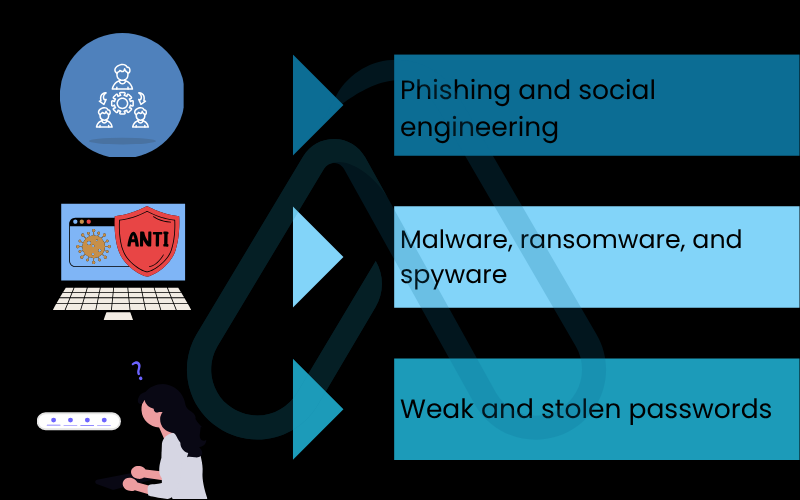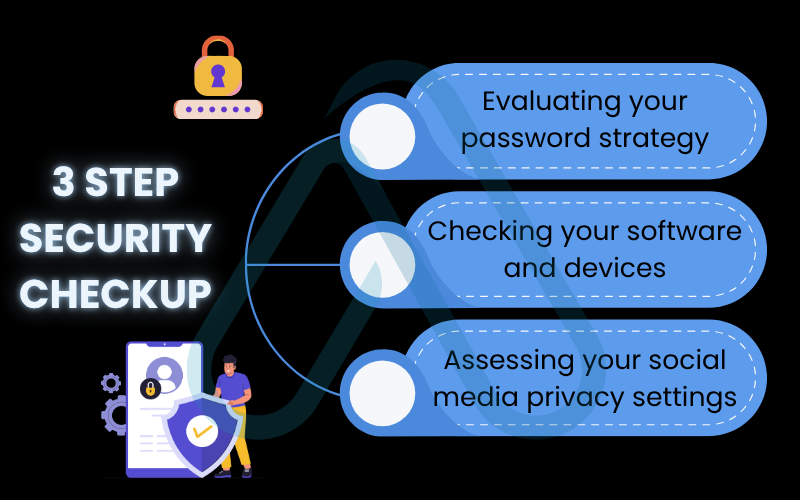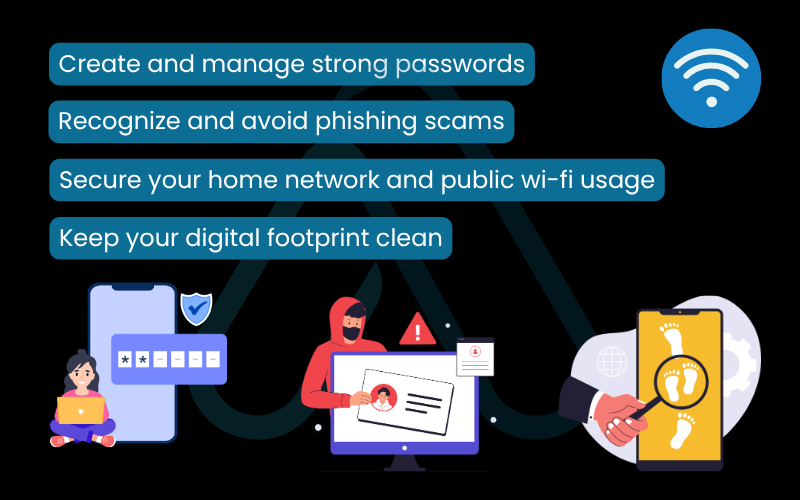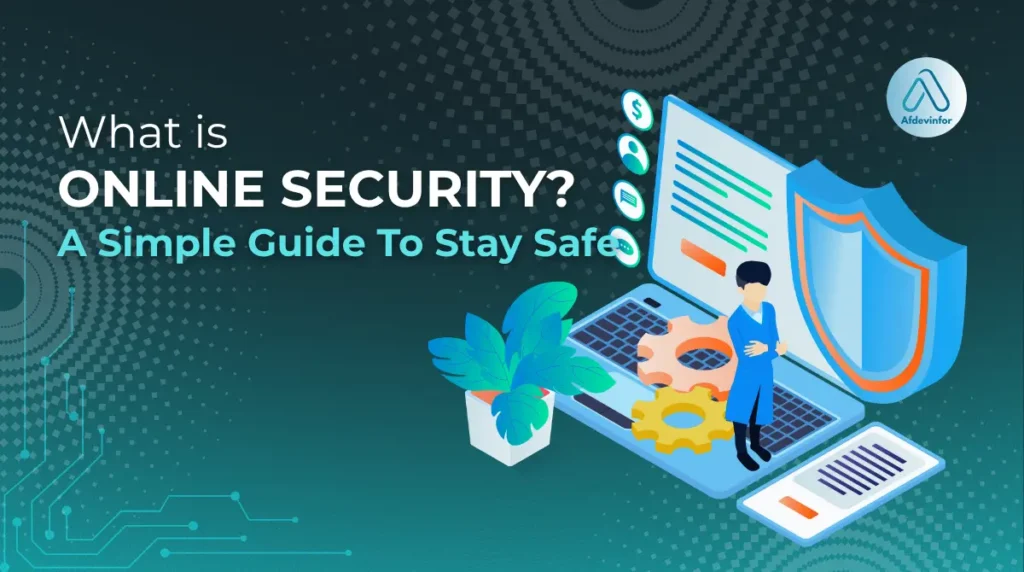Every time you log in, share a photo, or buy something on the internet, you’re stepping into a world that requires a digital seatbelt. That seatbelt is your online security. I’ve spent over a decade helping people understand what is online security, and I’ve learned that the best approach is to see it not as a one-time setup, but as an evolving practice. It’s the collection of habits, tools, and awareness you use to protect yourself from threats online. With so much of our lives from banking and work to our social connections. Now online, practicing good internet safety is more critical than ever.
Online security is the ongoing process of protecting your personal data, devices, and identity from theft, damage, or unauthorized access while you are connected to the internet.
1. Why online security is crucial in 2024 and beyond
The stakes have never been higher. As a technology expert, I see firsthand how threats are growing more sophisticated, but I also see how good security empowers people to use the internet with confidence. It’s not about being scared; it’s about being prepared. Here’s why you should make it a priority:
- Protecting your money: Good security shields your bank accounts, credit card details, and investment information from fraudsters.
- Safeguarding your identity: It prevents criminals from stealing your personal information to open accounts, take out loans, or commit crimes in your name.
- Securing your personal data: It keeps your private conversations, photos, and documents out of the wrong hands, preventing blackmail or reputational damage.
2. Clearing up the confusion with Security, privacy, cybersecurity
I often hear these terms used interchangeably, but they have distinct meanings. Understanding the difference is key to building a complete protection strategy. I like to use a castle analogy: cybersecurity is the entire castle’s defense system, online security is the guard at your personal gate, and digital privacy is what you choose to do inside your own room. Below is a simple table to make it even clearer:
| Term | Definition | Example |
|---|---|---|
| Online Security | The specific actions and tools you use to protect yourself online. | Using a strong, unique password for your email account. |
| Cybersecurity | The broad practice of defending networks, systems, and programs from digital attack. | A company setting up a firewall to protect its entire computer network. |
| Digital Privacy | Your ability to control what personal information is collected and shared about you online. | Adjusting your social media settings so only friends can see your posts. |
3. The most common online threats you’ll actually encounter
Before you can protect yourself, you need to know what you’re up against. In my experience, you don’t need to be a cybersecurity expert to stay safe. The most powerful first step is simply awareness of the common tricks and traps that are out there. Let’s look at the ones you’re most likely to face.
3.1. Phishing and social engineering
Phishing is a type of scam where attackers impersonate a legitimate company or person to trick you into giving up sensitive information like passwords or credit card numbers. These can come as emails, text messages (called ‘smishing’), or even phone calls (‘vishing’). They rely on social engineering. The psychological manipulation of people into performing actions or divulging confidential information. They often create a sense of urgency or fear to make you act without thinking. Effective phishing prevention starts with recognizing the signs.
Top 3 Phishing Red Flags:
- Urgency and Threats: Messages that say your account will be closed or you’ll be fined if you don’t act immediately.
- Generic Greetings and Typos: Legitimate companies usually address you by name, and professional emails are typically free of glaring spelling or grammar mistakes.
- Suspicious Links and Attachments: Always hover your mouse over a link before clicking to see the actual web address. Never open attachments from an unknown or unexpected email.
3.2. Malware, ransomware, and spyware
Think of malware (malicious software) as a digital virus designed to harm your computer or steal your data. It spreads through malicious downloads, infected email attachments, or compromised websites. I’ve seen three types cause the most trouble for everyday users, each with a different goal:
- Malware: The general term for any software designed to cause damage. This includes viruses that corrupt your files.
- Ransomware: This type of malware encrypts your files, making them inaccessible. The attackers then demand a ransom payment to unlock them.
- Spyware: As the name suggests, this software secretly installs itself on your device to spy on your activity, collecting passwords, browsing habits, and other personal data.
3.3. Weak and stolen passwords
This is one of the biggest yet most preventable threats I encounter. Hackers use automated software to run ‘brute-force attacks,’ which rapidly guess millions of common password combinations until they get in. If your password is something simple like P@ssw0rd1, it can be cracked in seconds. The danger is magnified when you reuse the same password across multiple websites. If one of those sites suffers a data breach, criminals will use your stolen password to try to log into your email, banking, and social media accounts. Strong password security is your first line of defense.

A weak password is easy to guess:P@ssw0rd1
A strong passphrase is much harder to crack:Correct-Horse-Battery-Staple
3. Your personal security checkup
Knowledge is great, but action is better. Let’s find out your current Online Security Score. I’ve designed this as a quick, honest self-assessment to help you pinpoint exactly where you can make the biggest improvements. Go through these steps to see where you stand.
3.1. Step 1: Evaluating your password strategy
Let’s start with the foundation of your online security. Do you use the same password for more than one important account (like email or banking)? If yes, your first priority is to change that. A password manager is the best tool for this job, as it can generate and store unique, strong passwords for every site you use. If you already use one, that’s fantastic! The next question is: have you enabled Multi-Factor Authentication (MFA) on it and your other critical accounts? If not, let’s fix that now. Remember, the goal is incremental improvement, not instant perfection.
3.2. Step 2: Checking your software and devices
Out-of-date software is like a house with an unlocked door. Hackers actively search for security holes in older versions of software. Here’s your action plan:
- Check Your Operating System: Are you running the latest version of Windows, macOS, iOS, or Android? These updates contain critical security patches.
- Update Your Web Browser: Your browser is your main gateway to the internet. Make sure it’s set to update automatically.
- Update Key Apps: Don’t ignore those app update notifications on your phone or computer. They often fix security flaws.
3.3. Step 3: Assessing your social media privacy settings
We often share more than we realize on social media. Criminals can piece together information from your profile to guess passwords or answer security questions. I recommend taking five minutes to review your privacy settings on platforms like Facebook and Instagram. Set your profile to private so only approved followers can see your posts, and be very selective about who you accept as a friend.
| Warning: Publicizing your full birth date, hometown, pet’s name, or other personal details gives identity thieves valuable clues. |

4. Cybersecurity best practices you can start today
Now that you’ve assessed your current state, it’s time to build stronger habits. I want to empower you with simple, actionable tips that make a real difference. These cybersecurity best practices will help you protect your data online without needing a degree in computer science.
4.1. Create and manage strong passwords
My number one piece of advice is to use a reputable password manager. It’s the single best way to manage unique, complex passwords for all your accounts. Instead of a short, complex password, I recommend a long ‘passphrase’, a series of random words that is easy for you to remember but incredibly hard for a computer to guess. Most importantly, enable Multi-Factor Authentication (MFA) everywhere it’s offered.
Your password is the key to your door, but MFA is the secret handshake you need to give the guard before they let you in.
4.2. Recognize and avoid phishing scams
Building on what we learned earlier, effective phishing prevention comes down to a simple rule I always follow: ‘When in doubt, don’t click. Verify independently.’ If you get an urgent email from your bank, don’t click the link in the email. Instead, open your browser, type in your bank’s official website address, and log in there. If there’s a real issue, you’ll see it on your account dashboard.
Here are the steps to take if you suspect a phishing attempt:
- Do not click any links or download any attachments.
- Do not reply to the message.
- Report the email as phishing or junk through your email provider.
- Delete the message.
4.3. Secure your home network and public wi-fi usage
Your home Wi-Fi router is the front door to your digital life. I always tell people to immediately change the default administrator password on their router—the one printed on the sticker. Also, ensure your network is using the strongest encryption available, which is typically WPA3 or WPA2. When you’re out and about, be extremely cautious on public Wi-Fi. Here’s a quick guide:
| Do on Public Wi-Fi | Don’t on Public Wi-Fi |
|---|---|
| Use a VPN to encrypt your connection. | Log in to your bank or other sensitive accounts. |
| Browse general websites. | Enter credit card information. |
| Assume someone is watching. | Trust networks that don’t require a password. |
4.4. Keep your digital footprint clean
Over the years, we all sign up for services and apps we no longer use. Each of these old accounts is a potential security risk, holding personal data that could be exposed in a breach. I recommend making it a yearly habit to clean up your digital footprint. Below are a few quick tips:
- Review and delete old, unused online accounts.
- Think before you post; the internet is permanent.
- Regularly check the permissions you’ve granted to apps on your phone and computer, and revoke any that are unnecessary.

5. The next frontier: AI, IoT, and the future of online threats
The digital world is always changing, and so are the threats. But I want to reassure you that even as technology advances, the core principles of good security, awareness, strong passwords, and skepticism, remain your best defense. Let’s look at what’s on the horizon so you can stay ahead of the curve.
5.1. How AI is creating smarter threats
Artificial Intelligence (AI) is being used by criminals to create more convincing scams. We’re now seeing AI-powered phishing emails that have perfect grammar and are highly personalized to you, making them much harder to spot. We’re also seeing the rise of ‘deepfake’ audio and video, where a scammer can clone a loved one’s voice for a convincing emergency phone call.
My advice remains the same: if you get an unexpected, urgent request for money or information, verify it through a separate, known channel. Call the person back on the phone number you have saved for them.
According to some security reports, AI-driven phishing attacks have seen a surge of over 1,000% in the last year, highlighting the need for increased vigilance.
5.2. Securing your ‘internet of things’ (IoT) devices
The ‘Internet of Things’ (IoT) includes all the smart devices in your home, speakers, cameras, thermostats, and even refrigerators. While they offer incredible convenience, I’ve found their security is often an afterthought. The biggest risk is that many come with weak, generic default passwords that users never change. An attacker who gets control of your smart camera or speaker has a foothold inside your home network.
Here is your quick checklist to secure these devices:
- Change Default Passwords: This is the most critical step. Change the default admin password on every smart device you own.
- Keep Firmware Updated: Just like your computer, IoT devices get security updates. Check the manufacturer’s app or website for instructions.
- Use a Guest Network: If your router supports it, put all your IoT devices on a separate guest Wi-Fi network. This isolates them from your main computer and phone.
6. How privacy laws like GDPR and CCPA affect you
You might have heard of data privacy laws like GDPR in Europe or CCPA in California. I see these not as a burden, but as an empowerment tool for users. Thanks to laws like these, you have more control over your personal data than ever before. They grant you rights, such as the right to see what data a company has on you and the right to request its deletion.
This connects directly to your online security: the less of your data that companies store, the less information about you can be stolen in a data breach. You can actively improve your data protection online by exercising these rights.
| Law | Region | Key Right It Gives You |
|---|---|---|
| GDPR | European Union | The ‘Right to be Forgotten,’ allowing you to request the deletion of your personal data. |
| CCPA | California, USA | The ‘Right to Know’ what personal information is being collected about you and to opt-out of its sale. |
7. FAQs about what is online security
Over my years in tech, I’ve been asked thousands of questions about online security. Here are my answers to some of the most common and important ones I receive, which can help you clarify your own security strategy.
What is the single most important thing I can do for my online security?
Use a password manager and enable MFA on your key accounts (especially email).
Is antivirus software still necessary?
Yes. It adds an extra protection layer against modern threats that built-in tools may miss.
How can I tell if a website is secure?
Check for HTTPS and a padlock icon, but remember this only confirms encryption. It does not guarantee the site is trustworthy.
Can I really be anonymous online?
No. Full anonymity is unrealistic; aim for better privacy and control instead.
Glossary of key terms
Here is a breakdown of some of the technical terms I’ve used in this guide.
| Abbreviation | Full Term | Meaning |
|---|---|---|
| AI | Artificial Intelligence | The simulation of human intelligence in machines, which can be used for both defensive and malicious purposes in cybersecurity. |
| CCPA | California Consumer Privacy Act | A state-level data privacy law in the United States that grants consumers more control over their personal information. |
| Encryption | Encryption | The process of scrambling data into a secret code to prevent unauthorized access. It’s like writing a letter in a secret language. |
| GDPR | General Data Protection Regulation | A comprehensive data protection and privacy law in the European Union that governs how personal data is collected and processed. |
| IoT | Internet of Things | A network of physical devices (like smart speakers and cameras) embedded with sensors and software that connect to the internet. |
| MFA | Multi-Factor Authentication | A security process that requires users to provide two or more verification factors to gain access to an account. |
| Malware | Malicious Software | Any software intentionally designed to cause damage to a computer, server, client, or computer network. |
| Phishing | Phishing | A fraudulent attempt to obtain sensitive information by disguising as a trustworthy entity in an electronic communication. |
| Ransomware | Ransomware | A type of malware that threatens to publish the victim’s personal data or perpetually block access to it unless a ransom is paid. |
| Spyware | Spyware | Malware that secretly observes the computer user’s activities without permission and reports it to the software’s author. |
| VPN | Virtual Private Network | A service that creates a secure, encrypted connection over a public network like the internet, hiding your IP address and online actions. |
| Zero-Day Exploit | Zero-Day Exploit | A cyberattack that occurs on the same day a weakness is discovered in software, before the developer has time to create a patch. |
8. Final thoughts
Navigating the digital world can feel complex, but taking control of your online security is entirely within your reach. My goal at Afdevinfo.com is always to make digital security accessible, and I hope this guide has shown you that protecting yourself isn’t about becoming a tech genius—it’s about building a few smart, consistent habits.
Here are the most critical takeaways I want you to remember:
- Security is a Practice, Not a Product: Staying safe online is an ongoing process of awareness and small, consistent actions.
- Master the Basics: Using a password manager and enabling MFA on your key accounts will protect you from the vast majority of common threats.
- Stay Skeptical and Verify: Always be cautious of unsolicited messages that create a sense of urgency. When in doubt, verify independently.
- You Are in Control: Every small step you take, from updating your software to reviewing your privacy settings, makes you significantly safer.
Your journey to a more secure digital life starts with one step. Start today by installing a password manager or turning on MFA on your primary email account. For more in-depth guides, explore our Online Security & Privacy categories on Afdevinfo.


